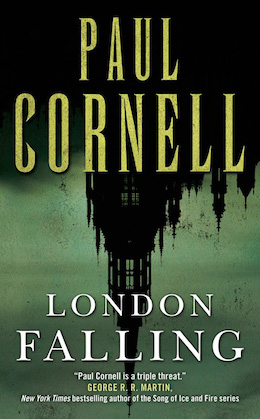Sometimes a book just sort of floats around in your brain-ether, not really sticking anywhere but constantly reminding you of its existence. Paul Cornell’s 2013 novel London Falling was like that for me. Without really learning anything about the story, I kept seeing this book on best-of lists and newsletters. It was always attached to phrases like “groundbreaking new urban fantasy.” Eventually I managed to pick up a hardcover copy at the public library.
The opening scenes of London Falling throw you into the middle of an extremely realistic police investigation, as two undercover officers infiltrate a gang despite serious tension between them. And frankly, I was disappointed. I’d been promised groundbreaking urban fantasy, not a British police procedural. I returned the book without getting past Chapter 1.
A year or so later, there was a deal on the Kindle version of London Falling, and I thought, what the hell. I was going to be appearing at a convention with Paul, and I figured reading the book for real might give us something to chat about. Why not give it one more shot? This time I went in knowing that Cornell was telling a story about a police squad, and that it would rather reasonably open with the squad members doing police-y things. I read through the opening investigation/manhunt, kept going, and…
Wow.
Sometimes writers feel overly schooled in their subgenre, as though they’ve read a thousand urban fantasy books and decided that they too could paint by numbers. What I like about Paul Cornell is that his books feel completely apart from anything that’s been written in the genre before. The Shadow Police books, for there are now three of them, read as though someone took a great procedural writer and said, “write about humans who find out that magic is real.” Cornell approaches this very, very well-trampled ground as though it’s the first day of spring and everything is budding. He writes about the intersection of magic and reality in a way that’s detailed, thoughtful, and utterly realistic without being bleak or dull.
It took me awhile to get used to it, honestly, because it fell so far outside the urban fantasy rhythms I was used to—which are, incidentally, distinctly American in voice. Just as I was getting comfortable with this breath-of-fresh-air genre entry, Cornell throws another curveball, or whatever is the equivalent of a curveball in cricket. In the second Shadow Police novel, The Severed Streets, Neil Gaiman abruptly turns up.
Of course, having a real-life person appear in a fictional story is nothing new. Comic books have been doing it for ages, and it’s fairly common for historical figures like Anne Boleyn or Wyatt Earp to appear in fiction. In fact, in retrospect I probably should have expected it: after all, Cornell moved into fiction after long stints in both comic books and Doctor Who novelizations. I don’t know a lot about Doctor Who, but I know that real historical figures turn up all the time.
When we first see Neil Gaiman, the character, our protagonists have heard there will be a gathering of London’s supernatural population that evening at a bar. Their leader, Inspector Quill, instructs everyone to arrive separately, undercover, to strike up conversations with those in attendance.
Which is how Quill finds himself in a brief, star-struck conversation with Neil freaking Gaiman, legendary master of fantasy. Because if there’s a seedy, dodgy get-together for the magically inclined, it makes sense that Neil Gaiman would be there, reading a book at the bar.
I was delighted when I came upon this scene. In fact, I distinctly remember that I first read it while at the gym, and I laughed out loud and almost fell off the elliptical machine. (Thanks a lot, Paul. I could have died.) My favorite thing about this scene is how dead-on accurately it portrays the strange dynamic between a “nobody” meeting a celebrity: there’s stammering, halting compliments, and in the end Quill can’t properly remember the man’s name. When I lived in L.A. I once tried to say hello to Jay Chandrasekhar, the director, co-writer, and co-star of Super Troopers, at the grocery store, and it was basically this exact scene.
When I read Severed Streets, however, I also assumed that Gaiman’s appearance was the literary equivalent of a cute little cameo, albeit with a very famous, and very still-alive, contemporary writer. But this is Paul Cornell we’re talking about, the man who makes well-traveled territory feel new. Gaiman doesn’t just appear with a little wink-wink wave and then gone again. He comes back, because he’s an actual character. Who does things.
Bad things.
I don’t want to give away any more than I already have, so let’s just say that although his appearance in the novel is limited to a handful of scenes, Neil Gaiman the Character is pretty damn instrumental to the story. And it feels … real. It feels like something the real Neil Gaiman might do. Which, of course, only makes the already-beautiful drawn characters feel more like real people.
The scary thing is, of course, that I almost missed it. If I hadn’t given London Falling another try, I might have missed out on the immense pleasure of the Shadow Police novels, including the Neil Gaiman scene and so much more. And, later, I might have missed out on introducing myself to Paul and getting to know one of the most genuinely kind human beings I’ve ever met.
Groundbreaking urban fantasy, indeed.
 Melissa Olson is the author of six Old World novels for 47North as well as the upcoming Tor.com novella Nightshades. She lives in Madison, WI, with her husband, two kids, three dogs, and a jittery chinchilla.
Melissa Olson is the author of six Old World novels for 47North as well as the upcoming Tor.com novella Nightshades. She lives in Madison, WI, with her husband, two kids, three dogs, and a jittery chinchilla.










